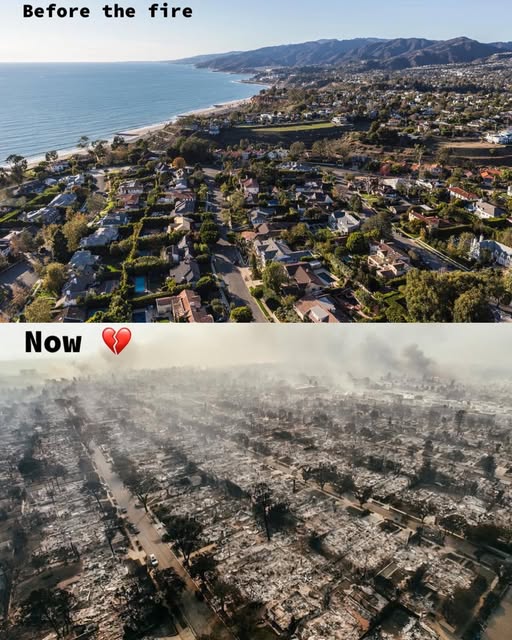Los Angeles, CA – The devastating wildfires that have ravaged Los Angeles and surrounding areas are projected to cost over $52 billion in damages and losses, setting a grim record as the most expensive disaster in California’s history. The staggering figure encompasses property damage, economic losses, firefighting efforts, and long-term recovery costs, underscoring the magnitude of the catastrophe.
As firefighting crews continue to battle residual blazes, residents, officials, and economists are grappling with the financial and human toll of the wildfires, which have left thousands homeless, destroyed critical infrastructure, and disrupted local economies.
Scope of the Disaster
The Los Angeles wildfires, which began in late December and rapidly spread across multiple counties, have scorched more than 800,000 acres, destroyed over 15,000 structures, and claimed dozens of lives. Entire neighborhoods have been reduced to ashes, and essential services such as power and water have been severely disrupted in affected areas.
The fires, fueled by prolonged drought, high winds, and record-breaking temperatures, have placed immense strain on California’s emergency services. More than 10,000 firefighters from across the state and nation have been deployed to contain the blazes, with aerial and ground operations costing millions of dollars daily.
The Financial Breakdown
The projected $52 billion cost includes a variety of direct and indirect impacts, such as:
- Property Damage: Losses from destroyed homes, businesses, and vehicles are estimated at over $30 billion.
- Economic Disruptions: Business closures, agricultural losses, and interrupted supply chains account for approximately $10 billion in economic damages.
- Firefighting and Emergency Response: The costs of deploying thousands of personnel, aircraft, and equipment are expected to exceed $2 billion.
- Healthcare and Relocation: The expenses related to treating fire-related injuries, respiratory illnesses, and mental health support for victims are estimated at $5 billion.
- Environmental and Infrastructure Repair: Rebuilding roads, power lines, and other critical infrastructure, as well as addressing long-term environmental damage, adds another $5 billion to the total.
The Human Toll
While the financial impact is unprecedented, the human cost of the wildfires is immeasurable. Thousands of families have lost their homes and personal belongings, while many more face ongoing evacuation orders and uncertainty about their future. The fires have also claimed over 60 lives, with hundreds more injured or missing.
Survivors describe the emotional devastation of losing everything. “I’ve lived in my home for 30 years, and now it’s gone,” said Susan Ramirez, a resident of the San Fernando Valley. “The money can’t replace the memories or the sense of security we had.”
Insurance Challenges and Federal Aid
California’s insurance industry is bracing for a surge of claims, with early estimates suggesting that insured losses alone could exceed $20 billion. However, many residents in high-risk areas are either underinsured or unable to secure coverage due to skyrocketing premiums, leaving them reliant on federal and state assistance.
President Biden has declared the wildfires a major disaster, unlocking federal funds to aid recovery efforts. FEMA has already allocated millions in emergency relief, with additional funding expected to support long-term rebuilding.
Climate Change: A Growing Threat
Experts point to climate change as a key factor exacerbating the intensity and frequency of wildfires in California. Rising temperatures, prolonged droughts, and unpredictable weather patterns have created a perfect storm for destructive fires.
“This disaster is a stark reminder of the urgent need to address climate change,” said Dr. Maria Lopez, a climate scientist at UCLA. “Without significant action, these events will only become more frequent and costly.”
Rebuilding and Resilience
The road to recovery will be long and challenging. Local and state officials are working on plans to rebuild homes and infrastructure, while prioritizing fire-resistant construction and community preparedness. The wildfires have also reignited debates about land management practices, including controlled burns and vegetation clearance.
Governor Gavin Newsom has called for increased funding for wildfire prevention and mitigation programs, emphasizing the need for proactive measures to reduce future risks. “We can’t afford to wait for the next disaster,” Newsom said during a press briefing. “We need bold action now to protect our communities and our state.”
Support for Victims
As communities begin to rebuild, organizations and volunteers are stepping up to provide assistance. Non-profits, local businesses, and individual donors have raised millions to support displaced families, while shelters and resource centers continue to offer food, clothing, and temporary housing.
Those wishing to contribute can donate to reputable organizations such as the Red Cross, California Community Foundation’s Wildfire Relief Fund, and Direct Relief.
Looking Forward
The Los Angeles wildfires will leave a lasting legacy, not only in terms of financial losses but also in the lessons learned about resilience and preparedness. As California faces an uncertain future shaped by climate challenges, the focus remains on rebuilding stronger and ensuring that communities are better equipped to withstand future disasters.
For now, residents and officials are united in their resolve to recover from this unprecedented tragedy, with the hope of emerging stronger and more resilient than ever. Further updates on recovery efforts and the investigation into the wildfires’ causes will be provided as more information becomes available.


Leave a Reply